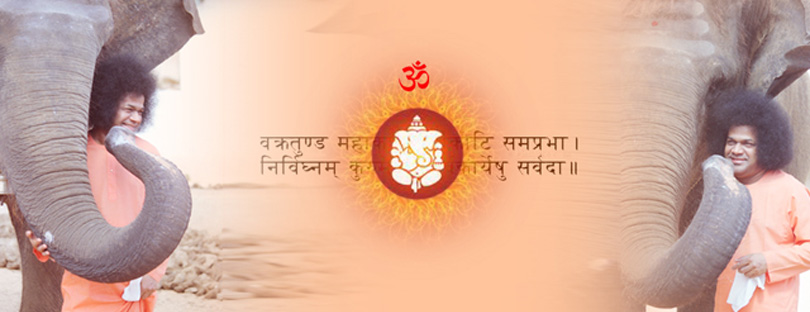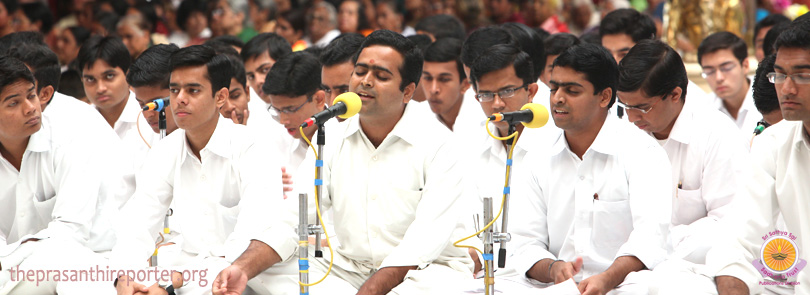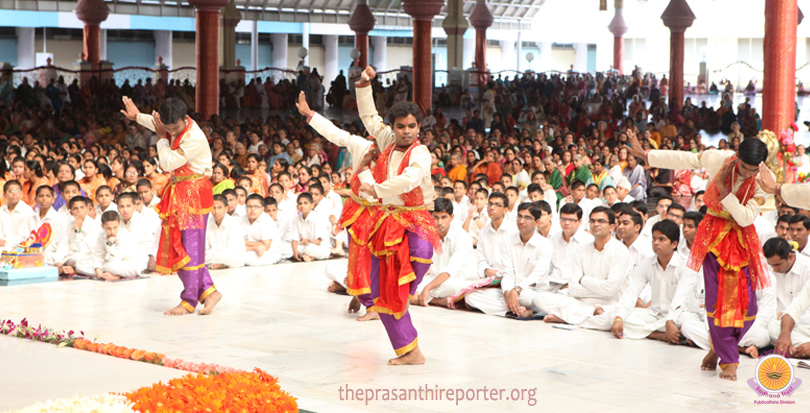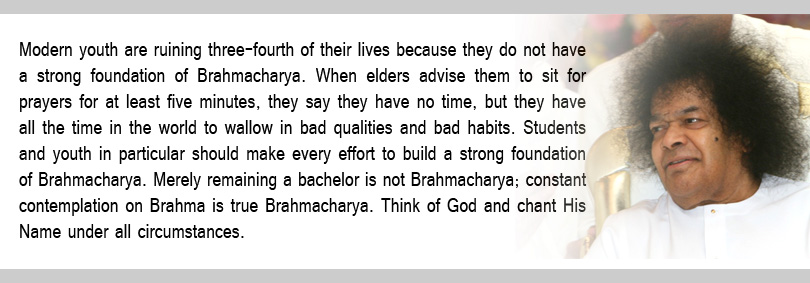
Ganesh Chaturthi in Prasanthi Nilayam…
Indian culture believes in the concept of pantheism – God can be identified with all the forces of nature and with all natural things. That is why our ancients worshipped trees. People worship snakes and elephants and our Indian mythology speaks volumes testifying this fact.
Among the Indian Gods and Goddesses, Vinayaka is given the prime place. Vinayaka has an elephant head and the body of a human. How Vinayaka assumed such a form is explained in the scriptures. Please read on for details …
Who is Vinayaka?
One who has no Nayaka (master) above Him is Vinayaka. He is the Master of all. Hence, we offer our prayers to Him before commencing any activity. He is also called Vighneshwara or Vighnahartaa, the Lord of and destroyer of obstacles. People mostly worship Him asking for Siddhi, success in undertakings, and Buddhi, intelligence. He is also the God of education, knowledge and wisdom, literature, and the fine-arts. The elephant-head of Ganesha is a symbol of intelligence, discrimination, and wisdom. The elephant is ever alert and eminently conscious of its surroundings. Its memory is strong and deep. It trends through thick forest imprinting huge foot marks on the track. One such print can subsume the marks left by other animals, both wild and tame. It moves majestically through. It is a path maker, helping others without being aware of it, because it is its nature.
The essential purpose of the Vinayaka Chaturthi festival is to teach a person to avoid the company of bad people and cultivate the company of the good. What does the term Ganapathi signify? 'Ga' means Buddhi or intellect, 'Na' means Jnana (Wisdom). 'Ganapathi' means one who is the Lord of the intellect and of wisdom. He is also the Lord of all Ganas (spiritual entities). Ganas also symbolise the senses. Ganapathi is thus the Lord of the senses.
Story of Ganesha's origin
Perhaps the most popular story regarding Ganesha's origin is the one derived from the Siva Purana. Mother Parvati once wanted to take an oil bath and created a boy from the wheat flour She had applied on Her own body, asking him to stand as a guard outside while She bathed. In the meantime Lord Siva returned home to find a stranger at His door, preventing Him from entering. In anger, Siva cut off the boy's head, upon which Parvati was stricken with great grief. In order to console Her, Siva sent out His troops (Gana) to fetch the head of anyone found sleeping with his head pointing to the north. They found an elephant sleeping thus and brought back its head. Siva then attached the elephantine head to the body of the boy and revived him. He named the boy Ganapati or commander of His troops, and granted Him a boon that anyone would have to worship Him (Ganesha) before beginning any undertaking.
There is another legend explaining Ganesha's origin: Once upon a time there was an Asura (demon) named Gajasura. He performed a penance. Easwara, pleased with his penance, offered him as a boon whatever he desired. Easwara is a deity who is easily propitiated. Hence he is known as Bhola-Sankara. When he is pleased with a devotee, He gives the devotee whatever he asks. Sometimes He gets into a 'difficult' situation, as in the case of Bhasmasura who was granted by Siva the boon to turn into ashes anyone on whose head he placed his palm. Immediately after getting the boon he wanted to test his power by trying to place his hand on Siva's head itself!
What was the boon Siva gave to Gajasura? The demon desired that fire should go forth from him continuously so that no one dared to approach him. Siva granted him the boon. Gajasura continued to do penance and Siva would appear before him off and on. Once Siva asked him what he wanted. The demon said: "I want you to dwell in my stomach." Siva granted the boon and lodged himself in the demon's stomach. Siva's consort Parvathi, searched for Siva everywhere and could not find Him. As a last resort, she went to Her brother, Vishnu, and appealed to Him to trace the whereabouts of her husband. The all – knowing assured her; "Don't worry, dear sister. Your husband is Bhola – Sankara. He grants readily whatever boon His devotee prays for, without considering the consequences. I suspect that Hmust have got into some trouble. I shall find out what has happened."
Vishnu, who is the director of the cosmic play, staged a small drama. He converted Nandi (Siva's bull) into a dancing-bull and led it before Gajasura, while Himself assuming the role of a piper playing music on the pipe. Gajasura was in ecstasy over the dancing performance of the bull: He asked the piper (Vishnu) what he wanted. The piper replied: "Can you give what I ask?" "What do you take me for? I shall readily give you whatever you ask." The piper said: "If that is so, release from your stomach Siva who is dwelling there." Gajasura then realised that the piper was none other than Vishnu Himself, Who alone could know the secret of Siva's presence inside his stomach. He fell at the Feet of Vishnu, released Siva from his stomach and prayed to Him for a boon. He said: "I have been blessed by many boons from You. My last request is that all should cherish my memory by worshipping my head after I pass away." Siva thereupon brought His son and placed Gajasura's head on Him.
Ever since, the tradition has prevailed in Bharat that, every auspicious function of any kind commences with worship of Ganapathi. It was the result of Siva's boon to Gajasura.
Vinayaka's Story
Vinayaka Chaturthi function is not complete without the narration of Vinayaka's story. It is said that anyone who looks at the moon on the night of the Ganesh Chaturthi will be falsely charged with theft or a similar crime. If someone inadvertently sees the moon on this night, he/she may remedy the situation by listening to (or reciting) the story of the Syamantaka jewel.
Briefly, Satrajit, who secured a jewel syamantaka from Surya, did not part with it even when Krishna the Lord of Dwaraka, asked for it saying it would be safe with Him. Prasena, the brother of Satrajit went out hunting wearing the jewel but was killed by a lion. Jambavan of Ramayana fame killed the lion and gave it to his son to play with. When Prasena did not return, Satrajit falsely accused Krishna of killing Prasena for the sake of the jewel. Krishna, in order to remove the stain on His reputation, set out in search of the jewel and found it in Jambavan's cave, with his child. Jambavan attacked Krishna thinking Him to be an intruder Who had come to take away the jewel. They fought each other for 28 days, when Jambavan, his whole body terribly weakened from the hammering of Krishna's fists, finally recognised Him as Rama.
As repentance for his having fought Krishna, Jambavan gave Krishna the jewel and also his daughter Jambavati in marriage. Krishna returned to Dwaraka with Jambavati and the jewel, and returned it Satrajit, who in turn repented for his false accusation. He promptly offered to give Krishna the jewel and his daughter Sathyabhama in marriage. Krishna accepted Satyabhama as His wife but did not accept the jewel.
Vinayaka Chaturthi at Prasanthi Nilayam
This festival is celebrated all over India and even in the overseas in a grand manner. Huge idols of Vinayaka made of clay are placed in a Pandal and elaborate Pujas (worship) are performed every day till the idol is taken for immersion.
This year, celebrating holy Ganesh Chaturthi, students from the Institute offered a string of hymns propitiating Lord Ganesha on 20th September morning at the Sanctum Sanctorum in Prasanthi Nilayam. Singing special hymns invoking the Lord, Who is hailed as 'Prathama Vandana', the students regaled the audience with devotional music interlaced with instrumental and dance for forty-five minutes.


Today people perform Vinayaka worship without actually understanding its significance. Vinayaka symbolizes the qualities of a true leader in all aspects. "Viyate Nayake Iti Vinayaka" meaning, He is a master unto Himself. In this world Vinayaka is worshipped by many. However, Vinayaka
does not worship anyone as He has no master above Him. Even Easwara, the father, worships His son Vinayaka, but it does not happen the other way.
On the significance of various dish preparations…
On this day of Vinayaka Chaturthi, people make kudumulu and undrallu as special dishes and offer them to Vinayaka. They are special and unique in the sense that they are cooked on steam without any oil content. Til seeds, rice flour and jaggery are mixed, made into balls, cooked in steam and offered to Vinayaka. You should enquire into the purpose of making such an offering. Til seeds are good for the eyes. Steam-cooked preparations without any oil content are good for your digestive system. One who partakes of such food will be free from blood pressure and blood sugar and will always enjoy sound health and happiness. Food preparations, which are cooked on fire with oil content, are harmful to jatharagni (digestive fire). Such food gives rise to various diseases. One can lead a long, happy and healthy life, if one avoids food with oil content. Vinayaka has a pot-belly but he has perfect health as he partakes of steam-cooked food without oil content.
Vinayaka as Vighneshwara – The Remover of all obstacles…
Vinayaka is also called Vighneswara (remover of obstacles). No obstacle can come in the way of one who prays to Vinayaka. Worship of Vinayaka confers success in spiritual as well as worldly endeavours. God grants happiness at two levels, pravritti (outward) and Nivritti (inward).

Importance of practice of Brahmacharya…
Human life can be compared to a four-storeyed mansion. Brahmacharya, Grihastha, Vanaprastha and Sanyasa (celibacy, householdership, recluse and renunciant) are the four stages of human life. Brahmacharya is the foundation; if the foundation is strong, the other three stages will be automatically taken care of. But the modern youth are ruining three-fourth of their lives because they do not have a strong foundation of Brahmacharya. When elders advise them to sit for prayers for at least five minutes, they say they have no time, but they have all the time in the world to wallow in bad qualities and bad habits. Students and youth in particular should make every effort to build a strong foundation of Brahmacharya. Merely remaining a bachelor is not Brahmacharya; constant contemplation on Brahma is true Brahmacharya. Think of God and chant His Name under all circumstances.

One who merely preaches without practising is only a teacher. He may be able to teach a few lessons but he will not be able to render any help in controlling your mind and attaining spiritual progress.
Our history is replete with sacred inner meanings. But the modern youth do not pay any attention to our history. They waste their time in reading novels and meaningless stories. These kathas (stories) will give only vyathas (sorrow). Divine story alone teaches you the ideal path.
His Story Is History…God's Story Is History…
His story is history. You should read such a sacred history, understand it and put it into practice. Sacred epics like the Ramayana, the Bhagavata and the Mahabharata are the repositories of great teachings. Likewise, the story of Vinayaka also has a great message for mankind. Vinayaka is the embodiment of wisdom. That is why all gods worship Him. On this day of Vinayaka Chaturthi, students place their textbooks in front of the Vinayaka idol and offer their prayers. The inner meaning is that they should pray for the divine wisdom to be bestowed on them. It is most essential that the students to worship Vinayaka on this auspicious day. He fulfills the desires of his devotees. He confers only anugraha (grace). He has no agraha (anger). Hence, not only the Bharatiyas, even the people of other countries, worship Vinayaka.
The Divine discourse came to an end with the bhajan "Hari Bhajana Binaa Sukha Shanthi Nahin…". A string of Ganesha bhajans followed before Mangala Arathi offering at 0950 hrs.
Even as bhajans continued, students from the Primary followed by senior students offered festive handmade greetings to Bhagawan at the Sanctum Sanctorum.
Lord Ganesha immersed with Festive Gaiety
The Ganesh Chaturthi celebrations came to a close on the third day of the festivity with the immersion of Ganeshas. The occasion was marked with great festive exuberance with en masse participation of students and staff members.
In the evening, marked by Prasanthi's special touch of grace and gaiety, scores of Ganeshas in varied hues and contour, flanked by batches of students and staff members, marched into the Sai Kulwant Hall shortly after 1630 hrs. beginning the proceedings.
Marching in, exhibiting festive hustle and bustle, Ganeshas, numbering 21, in fanciful shapes and decor, were arrayed in a disciplined order covering the entire stretch of Bhagawan's darshan pathway.
This is the occasion when Prasanthi showcases Ganeshas in varied theme, displaying colourful innovative ideas with the enthusiastic devoted bunch of students putting their best to impress upon The Over Lord of Prasanthi. This year too, like previous years, the procession had all the variety of craftsmanship, depicting spiritual and social themes of relevance.
After Mangala Arathi offering to the Ganeshas each group went round the Sanctum Sanctorum. Subsequently each of the Ganesha was brought to the Sanctum Sanctorum, presenting to the Over Lord, before retreating for immersion. The whole exercise was over in an hour.
Bhajans continued for the next 30 minutes and Mangala Arathi was offered at 1800 hrs.
TEXTO TOMADO DE: http://www.theprasanthireporter.org/2012/09/ganesh-chaturthi-in-prasanthi-nilayam/






















No hay comentarios :
Publicar un comentario